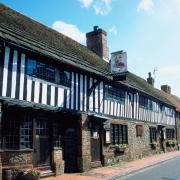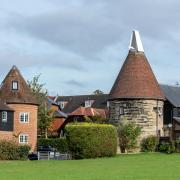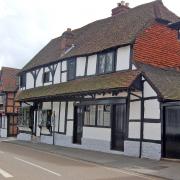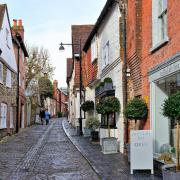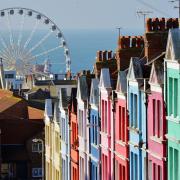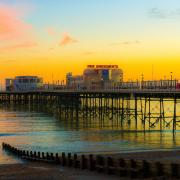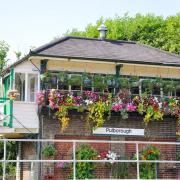Solution for the ‘Vision’ piece by Tony Ward in the Sussex Life January issue
***
Vision
From Scottish shore to Sussex shore,
Inventor, not conqueror,
but no less invading our lives.
The time had come to talk of many things,
from hatbox, needles, cycle lights,
from sealing wax and glue,
an image through the looking glass
the future came in view.
Shocked landlord of a shocked survivor.
Asked to leave.
Resettled in a Soho room,
a change of place, a change of pace.
A flying spot scanned Stooky Bill.
The dummy run repeated –
Claims accepted,
doubts resolved,
the sceptics now defeated?
New voices heard, new views take hold,
as fanned by flames, by molten glass,
new science takes shape, rejecting old.
Transmitted now across the seas,
His colours won, grey days no more,
One thousand lines at end of war –
too much, too soon, plans put on hold.
Patents filed, seeds sown,
But sixty years to grow.
His wartime projects saving lives,
But sadly not his own.
Returned to Sussex shore,
no fortune but his legacy,
and that worth so much more.
--------------------------------------------------
Solution - John Logie Baird: Inventor and Television Pioneer
(The poem this time is a bit uncomfortable to read. Some verses rhyme and read smoothly, others do not. This is deliberate. The idea was to reflect the flickering images, uncomfortable to watch, of the first mechanical television, and the ‘stop-start’ nature of later developments. Smooth progress was punctuated by step-changes in technology and interrupted by the Second World War.)
--------------------------------------------------
Explanation of embedded clues
John Logie Baird was born in Helensburgh, then Dunbartonshire, on 14 August 1888 and died in Bexhill, Sussex on 14 June 1946. Although rightly regarded as one of the greatest Scottish scientists, his initial pioneering work on Television was carried out in Sussex.
The poem title ‘Vision’ refers to both Baird’s inspiration, his vision of the future, and to our sense of sight as in the word Television.
In 1923 (aged 34) after suffering a health breakdown, he had moved to 21 Linton Crescent, Hastings. It was there that he built the world’s first working TV set, his very first transmitted image being a Maltese Cross. As his work continued he needed more space and so rented a workshop in Queen’s Arcade. Both buildings now mark his pioneering work by Commemorative plaques. That first set looked nothing like the TV sets we know today, being semi-mechanical, and of course he had to improvise the components. These included “an old hatbox, a pair of scissors, some darning needles, a few bicycle light lenses (four pence each), a used tea chest, sealing wax and glue”. It was powered by a small electric fan motor. When writing the poem, I’m afraid that the parallels with Lewis Carroll’s ‘The Walrus and The Carpenter’ (Through the Looking-Glass, 1872) was too hard to resist. Baird also thought that ‘The time had come ...’ to crack the problems that had defeated other inventors. Both included ‘sealing wax’ among their requisites, and of course Baird invented the ultimate ‘Looking Glass’.
Within the year he was able to successfully demonstrate his invention to the Radio Times. His experiments continued, but not without incident. After surviving a 1000-volt electric shock, his landlord must have decided that he was a bit of a fire risk and asked him to leave. He re-located his laboratory to Soho, made a technical breakthrough, and on 2 October 1925 transmitted the famous first greyscale television picture of the head of a ventriloquist’s dummy, “Stooky Bill”. He had used a “Flying spot” scanning technique. The demonstration was repeated on 26 January 1926 before an invited, but somewhat sceptical, audience of around 50 scientists and Royal Institution members. Baird, with an eye to publicity, had also invited a reporter from ‘The Times’. The event was a success and was the world’s first public demonstration of “real” television with live moving images and tone graduation. Quoted in The Times two days later, Baird admitted that he had been on edge – “Would they admit that a wretched nonentity* working with soap boxes in a garret had done something which many of them had stated was not possible?” (*Baird’s degree course at Glasgow had been interrupted by World War I and so he never completed his degree). Although his visitors had somewhat grudgingly accepted the claims he made for his ‘Televisor’, there was a reservation – “It has yet to be seen to what extent further developments will carry Mr. Baird’s system towards practical use.”
Over the next few years Baird made rapid progress, full tone graduation, moving images and by 1928 the first transatlantic TV transmission, colour transmission and stereoscopic TV (the forerunner of 3D TV). In 1931 he televised the first live transmission of the Epsom Derby, the beginnings of ‘outside broadcasting’. By 1938 he had developed a large-screen (15ft by 12ft) colour theatre projection system to bring a live boxing match to an audience of 3,000 in the Dominium theatre – another first. However, new technology had overtaken his semi-mechanical system. Cathode Ray Tube systems had finally become viable. In 1937, following comparative trials, the BBC went over to Marconi-EMI’s newly-developed electronic system, based on an American (RCA) system.
In the poem, the line “fanned by flames, by molten glass” refers to an event which probably didn’t help Baird’s case. A disastrous fire on 30th November 1936 burnt the Crystal Palace to the ground. Watched by an estimated 100,000 people, among them Winston Churchill, one theory was that the fire had been started by an electrical fault due to old wiring in the extensive Baird Television complex. Unknown to most people at the time, this largest broadcasting facility in Europe had been constructed right underneath the main concourse. Joseph Paxton’s iconic landmark, built to house the Great Exhibition of 1851, may have been the first victim of a television equipment overnight fire – what a reminder to switch the set off!
Baird himself switched to electronic systems. He developed his 1920’s“Flying Spot” scanning method for Cathode Ray Tubes (still in use), further developed his early form of HDTV 3D colour television, and in 1943 proposed a national 1000 line HDTV system to the Hankey Committee. This was a government task force set up to examine the future of television. He also proposed that most television programmes be pre-recorded (he had also invented a video recorder). Today, 95% of TV programmes are in fact produced in this way. His ideas were turned down. There were higher priorities at the end of the war, and lesser standards were adopted.
In failing health, Baird returned to “the fresh air and dry climate” of the Sussex Coast, to a semi-detached house in Station Road, Bexhill. The house was chosen so that he could continue to commute to his laboratory, but possibly he no longer had the stamina to fight his corner. He died in 1946, less than two years later.
Little is known about his top-secret work for the government in World War II, but it is thought that he contributed to the development of radar, signal jamming and mine detectors – as used at El Alamein and the D-Day landings.
Between 1923 and the late 1930’s he had filed 178 patents, and sown the seeds for most of the subsequent developments in television. His 1928 techniques were used for Neil Armstrong’s first colour transmissions from the Moon. The 405-line TV standard wasn’t upgraded to 625 lines until 1964 and we have only enjoyed his HDTV 3D standards in the last few years. Colour (PAL) transmissions took until 1967, and over sixty years after his large-screen Dominion Theatre transmission, the BBC reported on “a demonstration of large screen three-dimensional television”.
All this despite the fact that, in the early 1930’s, in the time of Lord Reith, the first Director General of the BBC, the corporation had been extremely reluctant to introduce a regular television service. The historian Asa Briggs believed that Lord Reith, the son of a minister of the Free Church of Scotland, saw television as a threat to society – “He thought it would really corrupt and ruin the nation”.
Baird never made any money out of his work, financing most of his research out of his own pocket. At the end of the 1920’s he could have sold his company for a fortune but it was said that he would have had no idea of what to do with the money. “A laboratory with all the apparatus I wanted was to me a perfect paradise”.
Baird’s rented house in Bexhill was demolished in 2007 and the area replaced with the Egerton Place development. This includes a new block of flats named ‘Baird Court’.
--------------------------------------------------
Acknowledgement of sources:
• 75-minute Television documentary ‘JLB - - the Man who Saw the Future’, last broadcast on BBC4 Monday 2 November 2009, available for free download from: www.alluc.to/movies/watch-jlb-the-man-who-saw-the-future-online/526041.htm - The documentary is based on the 2002 book ‘John Logie Baird: a life’ (Antony Kamm & Malcolm Baird (son), National Museum of Scotland Publishing).
• ‘Television and Me: The Memoirs of John Logie Baird’ (Autobiography, Mercat Press, 2004).
• www.openplaques.org/people/304
• www.bairdtelevision.com (an extensive, authoritative website, updated every few months by Iain L. Baird (grandson) and Malcolm H. I. Baird (son).
• Relevant websites found by searches for ‘John Logie Baird’, ‘John Logie Baird in Hastings’, ‘John Logie Baird in Bexhill’, ‘ John Logie Baird television patents’, ‘John Logie Baird and the Flying Spot technique’, ‘The Crystal Palace’, ‘Cause of the fire at Crystal Palace’, ‘Lord Reith of the BBC’.







